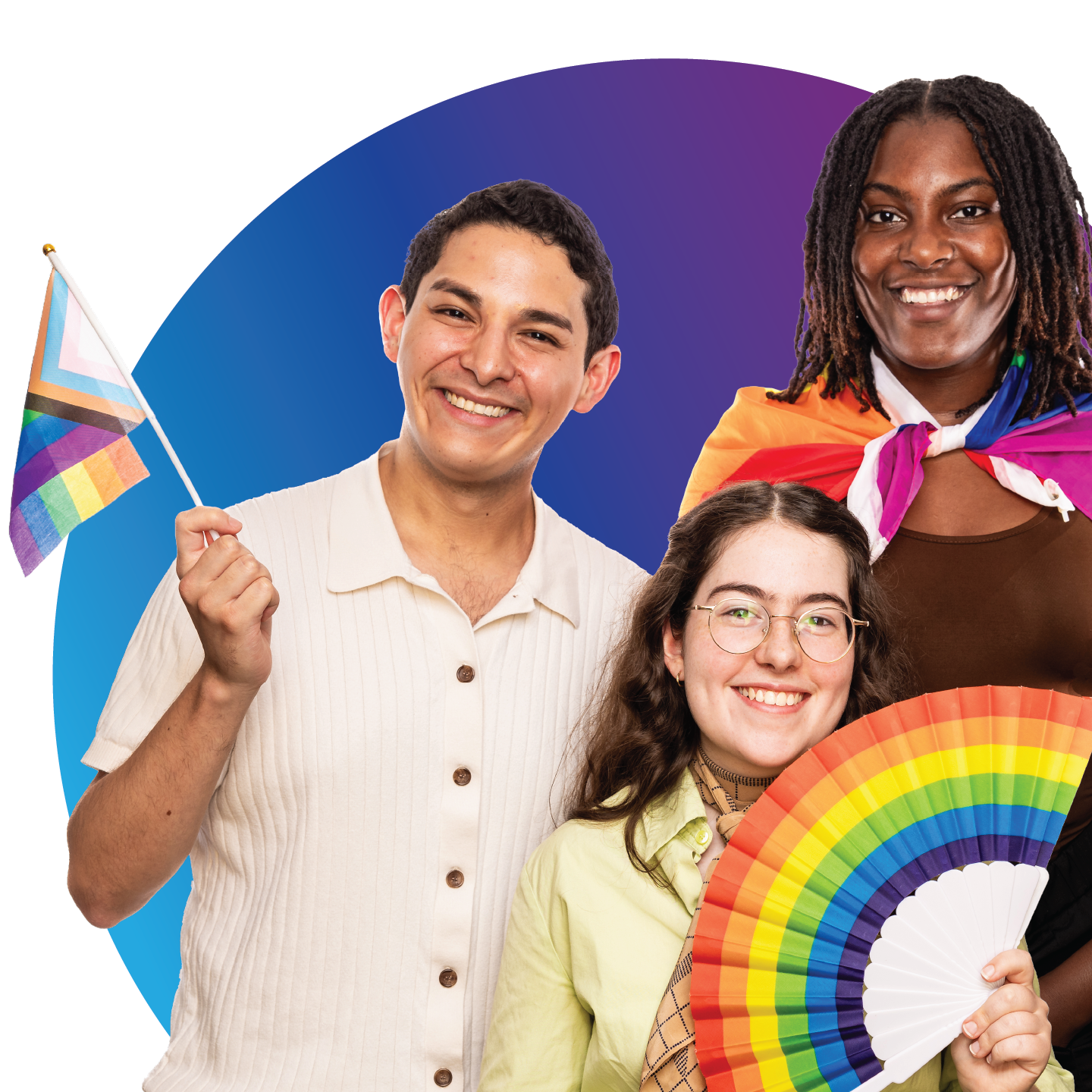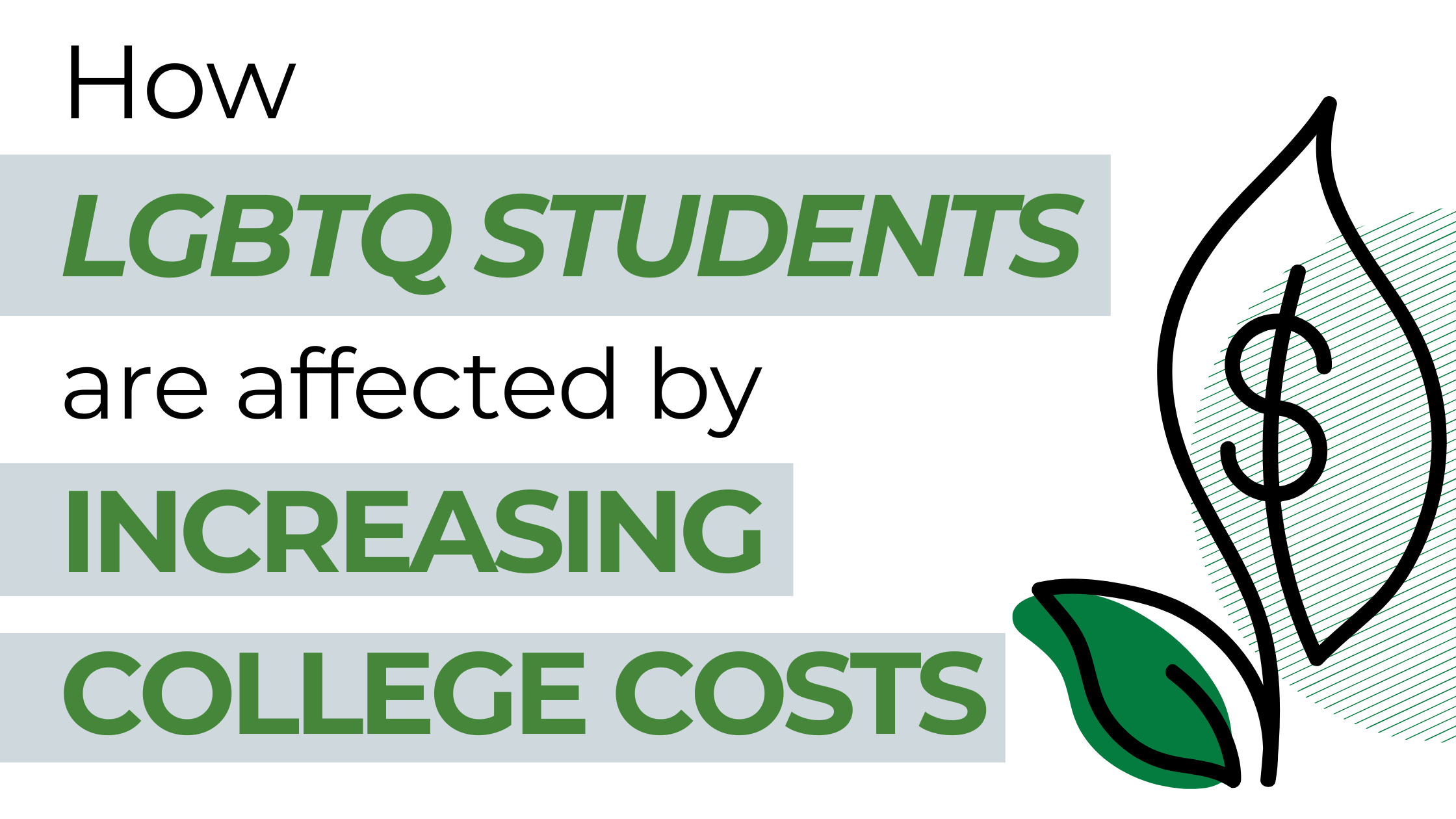Building LGBTQ+ Community on Campus

Community is a powerful tool for belonging. Building an LGBTQ+ group at your school can help you find your community and ensure that fellow LGBTQ+ students feel supported and empowered to make necessary changes.
Why build community on campus?
A joint report with Point Foundation and the Williams Institute at UCLA found that many LGBTQ+ students did not find the welcoming and supportive environment they may have been hoping for when seeking a new place to express themselves and learn in higher education.
Nearly one-third of LGBTQ+ people (32.6%) experienced bullying, harassment, or assault at college, compared to 18.9% of non-LGBTQ+ people. Specific forms of adversity were experienced by twice as many or more LGBTQ+ than non-LGBTQ+ people.
The negative experiences that LGBTQ+ students have in places of higher education have implications for LGBTQ+ students’ mental health, academic success, and retention. Harassment has been linked to academic disengagement and lower GPAs. A lack of acceptance or social integration within the university may harm academic ambitions and increase the risk of withdrawal, including transferring to another school. (Garvey, 2020)
“Clearly, institutions that focus on mattering and greater student involvement will be more successful in creating campuses where students are motivated to learn, where their retention is high, and ultimately, where their institutional loyalty for the short- and long-term future is ensured.” (Schlossberg, Lynch, and Chickering, 1989)
TIPS TO FIND AND BUILD LGBTQ+ COMMUNITY ON CAMPUS
Point Scholars suggested the tips below to help guide your community-building journey.
- DEFINE YOUR GROUP’S PURPOSE
Before beginning your community-building project, ask yourself:
- What is your hope for this group?
- Does the group align with the needs of the community on your campus?
- Do similar groups already exist on campus?
- LEARN ABOUT YOUR COMMUNITY
- The LGBTQ+ community is vast, with folks who have so many different life experiences. Being a community member doesn’t make you an expert on every other LGBTQ+ person’s experience. Take some time to read about different LGBTQ+ identities and experiences to help you create a safe space for all LGBTQ+ students to enjoy.
- Many LGBTQ+ Centers do not talk about race or racism as aspects of some LGBTQ+ students’ experiences, creating presumptively homogenous LGBTQ+ spaces. Rather than assuming everyone who shares your identity shares your worldview, enrich yourself with insight from people who are unlike you.
- Work within your context. Are you in a school or state that restricts LGBTQ+ or other student services? You are not alone. Some local and state laws directly prohibit schools from offering classes and services with LGBTQ+ content. Find out about your state’s restrictions from the Chronicle of Higher Education’s Tracker.
- Make sure you’re listening to the issues that matter to the LGBTQ+ community at your school. If possible, find out the LGBTQ+ history of the school you attend or the community around you.
- The LGBTQ+ community is vast, with folks who have so many different life experiences. Being a community member doesn’t make you an expert on every other LGBTQ+ person’s experience. Take some time to read about different LGBTQ+ identities and experiences to help you create a safe space for all LGBTQ+ students to enjoy.
- BRING TOGETHER LGBTQ+ STUDENT CHANGEMAKERS
- Talk to friends and peers about your group as a way to help you to gauge interest. Be ready to answer some basic questions and receive feedback and suggestions.
- Identify gaps in your campus's existing LGBTQ+ resources and community. What do you think the community at your school needs?
- Build a team that is passionate about LGBTQ+ belonging, whether this is starting/leading an LGBTQ+ student club or just connecting with other student changemakers. It is essential to make this a safe space for LGBTQ+ students at your school.
- For more information about building a Gender & Sexualities Alliance club, visit GLSEN or the GSA Network
- Find out if your campus has an LGBTQ+ Center using the Consortium of Higher Education’s map of LGBTQ+ centers.
- Your group can act as powerful changemakers for LGBTQ+ inclusion on campus by creating an environment where all LGBTQ+ students feel seen and supported.
- Fewer LGBTQ+ people experienced a sense of belonging at their college (71.9%) compared to non-LGBTQ+ people (83.5%). Students with disenfranchised identities (e.g., LGBTQ+ students of color; students with disabilities) may face enhanced stigma and identity-based stressors, including an intensified sense of not belonging (source).
- GLSEN has resources to ensure that your LGBTQ+ student group is representative of all community members. See also the GSA Network’s Two-Spirit Initiative.
- Talk to friends and peers about your group as a way to help you to gauge interest. Be ready to answer some basic questions and receive feedback and suggestions.
- FIND ALLIES
- Build coalitions on campus with student organizations that may have different identities but hold the same values. Not only does this reflect the intersecting identities in the LGBTQ+ community, but the more bonds with other student organizations, the more influence you’ll have when taking action for equality and fairness on campus.
- See GSA Network’s guide to coalition building and Campus Pride’s student leader guides to queer coalition building with communities of color and disability rights activism.
- See GSA Network’s guide to coalition building and Campus Pride’s student leader guides to queer coalition building with communities of color and disability rights activism.
- Find teachers/faculty in your corner who can help you and possibly serve as advisors to an LGBTQ+ group. Together, organize campaigns and wider community outreach efforts. Work with your officers and staff advisor to figure out a meeting schedule and continue to grow the group's size.
- Getting faculty support for your efforts to build LGBTQ+ community helps build a long-term community, outlasting your time as a student. It also shows university leadership that change is important to their employees, not just students.
- See Point’s Challenging School Policies and Decisions resource for more information about connecting with faculty.
- See Point’s Challenging School Policies and Decisions resource for more information about connecting with faculty.
- Getting faculty support for your efforts to build LGBTQ+ community helps build a long-term community, outlasting your time as a student. It also shows university leadership that change is important to their employees, not just students.
- On-campus groups are required to register, often with the Office of Student Life. To register your group, you might need a more structured plan, including leadership/officer roles, bylaws, or a mission statement. Look into your campus's registration requirements and ask your staff advisor for support.
- Bring LGBTQ+ issues into your classes and everyday campus life when relevant and safe. Do so as an opportunity to address stigmas and misunderstandings with well-intentioned people who may be misinformed.
- Build coalitions on campus with student organizations that may have different identities but hold the same values. Not only does this reflect the intersecting identities in the LGBTQ+ community, but the more bonds with other student organizations, the more influence you’ll have when taking action for equality and fairness on campus.
- CHECK IN
- Once your group is registered, it is time to be an engaged club officer. In addition to your internal duties, this can include providing regular updates, attending trainings, and participating in programming.
- As you check in with your new community, be thoughtful in engaging them with questions, openings, closings, and activities that connect to all aspects of their humanity.
-
- One communication process you can use is the Circle Process—a Native tool used over thousands of years to facilitate communication, community and relationship building, decision-making, and conflict resolution. It involves a talking piece, an opening and closing, and a series of questions to facilitate dialogue. Read how a Circle Process meeting works via Suffolk University.
- Another effective and flexible format for hosting large group dialogue is a World Café. This technique brings together individual ideas into one comprehensive message. Find out how to host a World Café here.
-
- Don’t forget to check in with yourself too! More LGBTQ+ people reported mental health struggles in college compared to non-LGBTQ+ people, according to our research. Take care of your mental health and make sure you are spending time with people who are healthy for you. Organizing meet-ups, communicating with faculty, and educating people can be extremely draining. To avoid burnout and be able to continue to do your essential community-building work, you must set aside time to take care of yourself. Find mental health resources for LGBTQ+ people at NAMI and The Trevor Project.
- Once your group is registered, it is time to be an engaged club officer. In addition to your internal duties, this can include providing regular updates, attending trainings, and participating in programming.
Related Posts
October 31, 2022, teampoint

Challenging School Policies and Decisions
DOWNLOAD THE RESOURCE Updated March 2025 Despite great strides in LGBTQ+ belonging in recent years...
November 02, 2023, Point Foundation

The Impact of Anti-LGBTQ+ Legislation in Higher Ed
"Recent legislation just seeks to divide us further. It hopes to prevent so much progress that has...
August 10, 2023, teampoint

High Price of Higher Education
The price of higher education is increasing and the cost of denying access to those who want to...